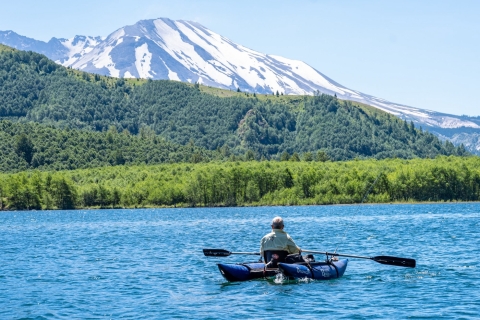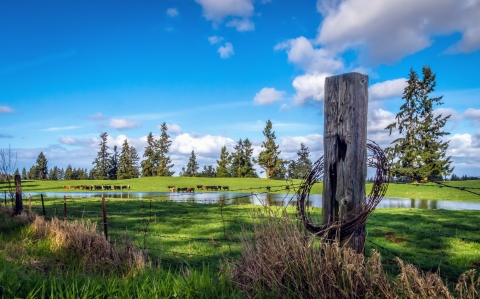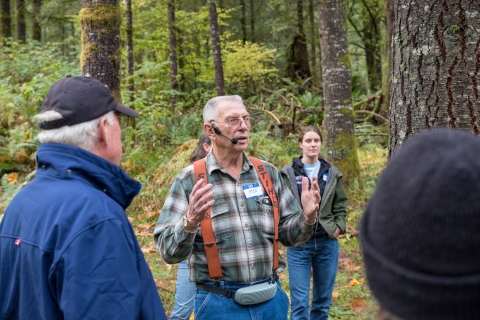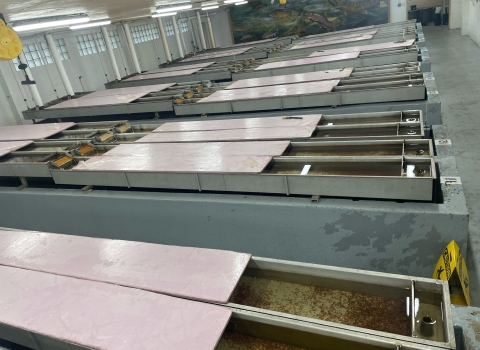By Jan Peterson, for the U.S. Fish and Wildlife Service’s Pacific Region
The region of Oregon and Washington between the Cascade Range and the Pacific Ocean has a rich diversity of wildlife, topography and land uses.
The environmental challenges this region faces are no less diverse.
Climate change, wildfires, development, invasive species invasive species
An invasive species is any plant or animal that has spread or been introduced into a new area where they are, or could, cause harm to the environment, economy, or human, animal, or plant health. Their unwelcome presence can destroy ecosystems and cost millions of dollars.
Learn more about invasive species , policy issues, and sometimes conflicting goals can all threaten the region’s shared natural and cultural resource values.
The Cascades to Coast Landscape Collaborative (CCLC), convened by the U.S. Fish and Wildlife Service’s Science Applications Program, is dedicated to finding collaborative solutions to these threats. The group’s goal is to achieve functioning, resilient ecosystems and working lands across the Pacific Northwest over the long term.
John Mankowski, the Cascades to Coast’s partnership facilitator, says collaboration is vital.
“It’s really the best way to tackle the most vexing conservation challenges we face. Our challenges are increasingly complex and larger than any one entity can handle alone,” he says. “They have to do with landscape-scale impacts like climate change climate change
Climate change includes both global warming driven by human-induced emissions of greenhouse gases and the resulting large-scale shifts in weather patterns. Though there have been previous periods of climatic change, since the mid-20th century humans have had an unprecedented impact on Earth's climate system and caused change on a global scale.
Learn more about climate change , habitat loss and fracturing our landscapes with roads and development. Landscape conservation presents a huge opportunity … to touch down in people’s lives, to address climate change and development impacts, and to create resilient landscapes – all at the same time. Landscape conservation addresses biodiversity, water and air, food and fiber, jobs and livelihoods, and people’s identities.”
The landscape collaborative’s partners include people who represent a cross-section of specialties, interests, industries, and governmental and non-governmental organizations. The leadership team meets monthly and includes three Service employees: Kaitlyn Landfield, science communications coordinator; Alan Yanahan, conservation biologist; and Bill Vogel, wildlife biologist
Partners include Oregon’s departments of Fish and Wildlife, Land and Conservation Development, Department of Transportation and Parks and Recreation, the Washington Habitat Connectivity Working Group, and Washington’s departments of Natural Resources, Fish and Wildlife and its State Recreation and Conservation Office.
Also involved are the Chinook Indian Nation, Confederated Tribes of the Colville Reservation, Columbia River Inter-tribal Fish Commission, Cowlitz Tribe, Quinault Indian Nation and Yakama Nation.
Non-governmental groups offering their expertise include Conservation Northwest, Audubon Washington, Defenders of Wildlife, Ecotrust, Conservation Biology Institute, Pinchot Institute for Conservation and The Nature Conservancy.
Industry partners include the Center for Inclusive Entrepreneurship, David Evans and Associates, Environmental Science Associates, Greenwood Resources, Hampton Lumber, PC Trask and Associates, and Port Blakely.
Agricultural and forest landowners – large and small – are also engaged, as the footprint for the Cascades to Coast collaborative contains a large number of working farms and forests.
“You have all these people and organizations who have unique experiences, different amounts of resources, different abilities to engage with partners to support conservation projects. This is a way to share resources to get stuff done,” says Jeff Azerrad, environmental planner at the Washington Department of Fish and Wildlife.
“No one organization has all the expertise and all the resources to do some of the big work these partnerships are doing. These partnerships, including the CCLC, are doing things that are valued,” he says.
Vicki Finn, conservation coordinator in the Service’s Science Applications program, says that while the Service provides funding, the partnership is very self-directed.
“Once the CCLC decided to focus on maintaining habitat connectivity and working lands, it was a great fit for our agency’s mission. We want working lands to stay working while conserving wildlife,” Finn says. “Finding the balance is never easy, but by working together and listening to a wide variety of co-managers and partners, we are finding ways to do both.”
Mankowski says the group reaches a wider circle of 75 to 100 partners through workshops and seminars once or twice a year to better understand and address the region’s priorities.
“The objective is to get ahead of what’s coming in terms of landscape-scale impacts so we don’t have to manage so much by crisis and conflict,” Mankowski says. “We know that healthy, connected landscapes are essential – for clean water, healthy ecosystems, cultural heritage, vibrant communities and economies, climate resilience, climate mitigation, flood and fire control, outdoor recreation, and a local sense of place. And yet our approaches to these critical issues are too often piecemeal, scattered, isolated and incomplete.
“The CCLC is about bridging divisions. We bring people together across geographies, jurisdictions, sectors, and cultures to re-weave fragmented landscapes and safeguard the ecological, cultural and economic benefits they provide.”
The Cascades to Coast Landscape Collaborative strongly focuses on bringing small farm and forest owners into the conversation. They developed a tool, the Conservation Program Explorer, that allows landowners to easily find incentive programs that apply to their land rather than sifting through countless federal, state, and local government and NGO websites.
Ken Miller, who owns 150 acres of timberland, helped the collaborative understand the needs of small forest landowners like himself.
Miller says that to his way of thinking, it compliments the Washington Department of Natural Resources stewardship program. He said DNR foresters previously met with landowners in person to help identify programs that applied to their situation.
“That was pretty darn good customer service because as I worked with them, I learned to trust them. Those days are long gone, so this was a way to get in touch with different interests,” Miller says.
The Cascades to Coast Landscape Collaborative has also developed a web tool for natural and cultural resource practitioners and policymakers, the Coastal Northwest Landscape Conservation Mapper. Launched in 2021, the tool provides spatial information on the conservation values, working lands, and habitat connectivity priorities of the landscape. It’s designed to visually highlight landscape conservation opportunities and spark conversations about landscape planning.
Finn says Cascades to Coast Landscape Collaborative’s ongoing work is vital to meeting the challenges of rapidly transforming ecosystems.
“It is hard to keep up,” Finn says. “CCLC embraces the challenge recognizing solutions must work for both wildlife and people.”
In the Pacific Northwest (and across North America), a transformative change in conservation is taking place. People are connecting across private and public lands, and from cities to the wildest places, to reweave the natural and cultural fabric of the larger landscapes that define and sustain our character and quality of life. Conservation is no longer just about remote protected areas, piecemeal conservation, or top-down processes.
People are stepping forward in community-grounded ways, through partnerships such as the Cascades to Coast Landscape Collaborative, to embrace and advance something more integrated and dynamic. Individual acts of conservation are being enriched by ecosystem-scale thinking—the scale at which nature and culture function. It is an exciting time.
The Cascades to Coast Landscape Collaborative contributes to the administration’s America the Beautiful initiative, which is a decade-long campaign to conserve, connect and restore 30% of our lands and waters by 2030. The effort aims to support locally led and voluntary conservation and restoration efforts across public, private, and Tribal lands and waters to create jobs and strengthen the economy’s foundation, tackle the climate and nature crises, and address inequitable access to the outdoors.
For more information about the Cascades to Coast Landscape Collaborative, contact John Mankowski (john@mankowskienvironmental.com or Vicki Finn (vicki_finn@fws.gov).







